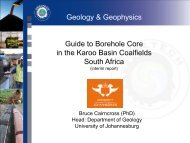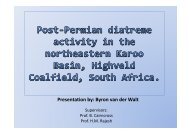coaltech upper olifants river catchment wetland inventory ...
coaltech upper olifants river catchment wetland inventory ...
coaltech upper olifants river catchment wetland inventory ...
You also want an ePaper? Increase the reach of your titles
YUMPU automatically turns print PDFs into web optimized ePapers that Google loves.
Disturbances such as construction activities and overgrazing favour the establishment of<br />
alien and invasive species. The most common invasive plants in the riparian zones include<br />
Acacia mearnsi (Wattle) and Sesbania sp (Palmer et al 2002, Marneweck 2003, De Lange et<br />
al 2003, Marneweck 2004a, Wetland Consulting Services 2005).<br />
Alien invasive plants have a huge impact on the natural environment and the Working for<br />
Water group was started to clear invasive vegetation. A study was conducted by Versfeld et<br />
al in 1998 to assess the current distribution of invasive species. Results of the study<br />
indicated that alien vegetation use between 0 % and 5 % of the available water in the<br />
<strong>catchment</strong>. It is however, necessary to update the database again, since the database was<br />
only intended as a baseline study.<br />
Invasion of the riparian habitats is taking place in all of the provinces, with approximately<br />
1.4% of the general landscape invaded by alien species. Invasive plants therefore, cover a<br />
greater extent than commercial plantations (Versfeld et al 1998).<br />
The control of invasive plant species is addressed under CARA, Regulations 15 and 16.<br />
Invasive species are classified under three categories according to their invasiveness, uses<br />
and threat to the environment. Category 1 invaders are species that will no longer be allowed<br />
to occur on any property in South Africa, because their harmful properties outweigh their<br />
useful qualities. The plants may not be planted or propagated in any way and existing<br />
individuals should be removed. These species may not be transported or allowed to disperse<br />
(Landcare South Africa).<br />
Category 2 plants are species proven to have a potential for becoming invasive, but with<br />
commercial value. Provision is made in CARA in Regulation 15 and 16 for the species to<br />
occur in certain demarcated areas, but the species have to be removed from all areas<br />
outside the demarcated areas. An area for the growing of category 2 plants can only be<br />
demarcated by the Executive Officer. Since the growing of category 2 plants qualifies as a<br />
water use, a water use licence has to be obtained from DWAF for an area of 1ha and larger.<br />
It is also important to ensure that all reasonable steps have been taken to stop the spread of<br />
the species to other areas, through seed or vegetative growth. Category 2 plants may never<br />
occur within 30m of the 1:50 year floodline of any <strong>wetland</strong>s or watercourses (Landcare South<br />
Africa).<br />
Wetland Database for UORC - 52 -




